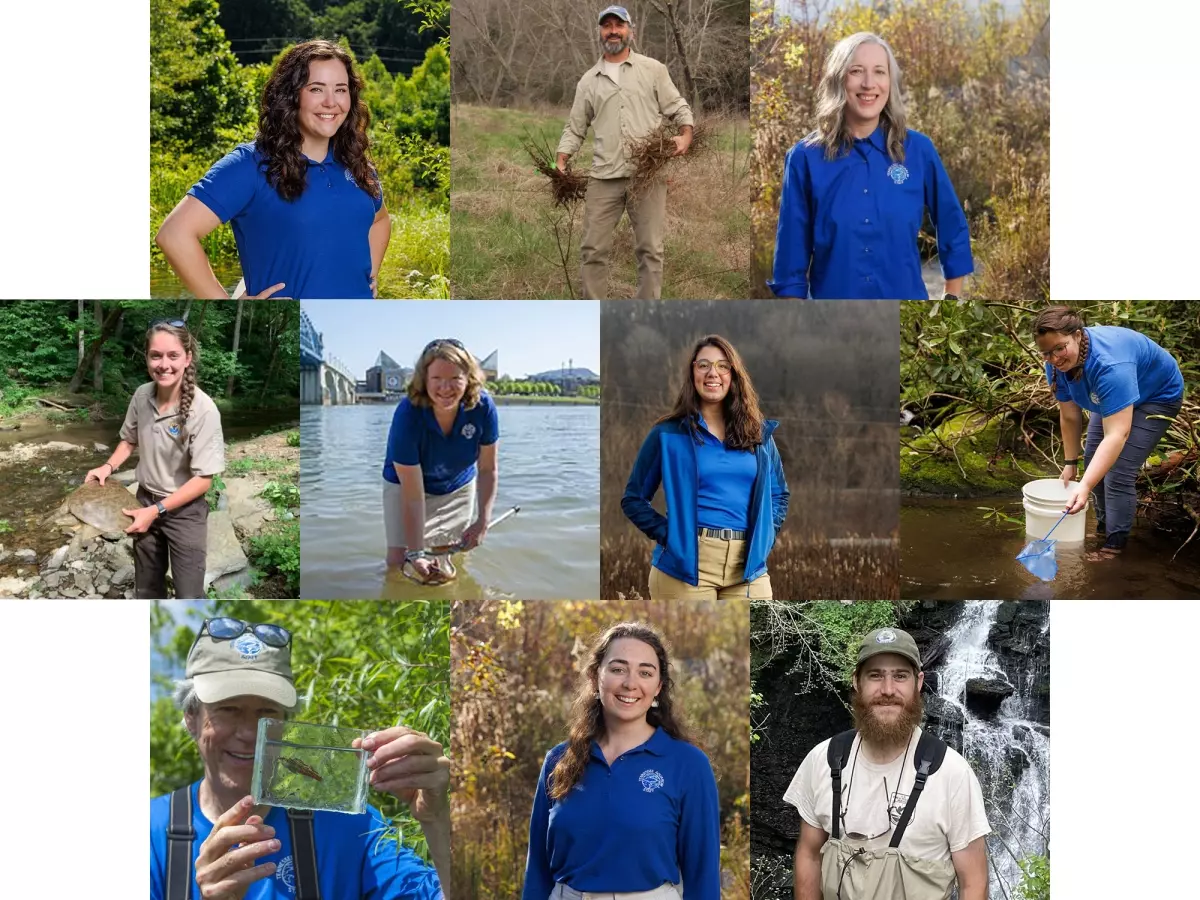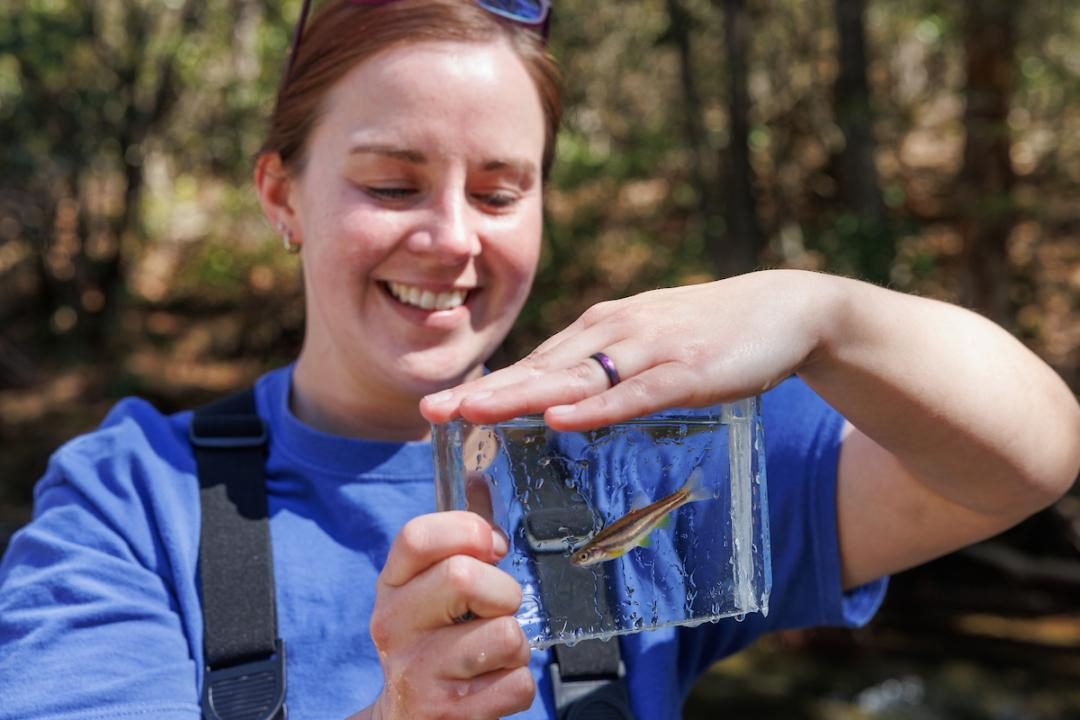Displaying items by tag: laurel dace
On Endangered Species Day, a timely honor for saving a rare Cumberland Plateau fish
USFWS names Laurel Dace Team a 2024 Recovery Champion
 From left to right, top to bottom: Sarah Kate Bailey, Geoff Call, Stephanie Chance, Makenzie Foster, Anna George, Helaina Gomez, Abbey Holsopple, Bernie Kuhajda, Tigris Nevans and Warren Stiles. Image Details
From left to right, top to bottom: Sarah Kate Bailey, Geoff Call, Stephanie Chance, Makenzie Foster, Anna George, Helaina Gomez, Abbey Holsopple, Bernie Kuhajda, Tigris Nevans and Warren Stiles. Image Details
Congratulations to the honorees of the US Fish & Wildlife Service award for the Southeast
“During the summer and fall of 2024, a prolonged drought emerged as a preeminent threat to the Laurel dace, a freshwater minnow native to Tennessee. During this pivotal time, the Laurel Dace Rescue Team provided for the ongoing conservation and survival of the endangered fish by developing a water level monitoring protocol and planning for individuals to be collected and brought into captivity to maintain representation from the last two wild populations. In a short period, the team collaborated to rescue, transport, and house more than 200 fish while maintaining separation of individuals from each population. The Aquarium led the ‘Race for the Laurel Dace’ fundraising campaign, which helped significantly raise public awareness of the species’ plight and secure funding to help ensure the availability of the specialized emergency care needed for the rescued individuals. The Service’s diligent work to sample, collect, transport, and care for individual laurel dace were invaluable to this effort.”
Sarah Kate Bailey - Tennessee Aquarium
Geoff Call - U.S. Fish and Wildlife Service
Stephanie Chance - Tennessee Aquarium
Makenzie Foster - U.S. Fish and Wildlife Service
Anna George - Tennessee Aquarium
Helaina Gomez - Tennessee Aquarium
Abbey Holsopple - Tennessee Aquarium
Bernie Kuhajda - Tennessee Aquarium
Tigris Nevans - Tennessee Aquarium
Warren Stiles - U.S. Fish and Wildlife Service
Recovery Champions are U.S. Fish and Wildlife Service staff and their partners whose work is advancing the recovery of endangered and threatened species of plants and animals.
Hellbender Press previously reported on emergency efforts to rescue the fish from drought conditions on Walden Ridge.
‘A day of hope:’ Months after rescue from drought, endangered laurel dace return to the wild
 Tennessee Aquarium Reintroduction Biologist II Teresa Israel examines a critically endangered laurel dace before its reintroduction to the wild in March 2025. In July 2024, about 300 of these fish — considered by scientists to be among the most imperiled in North America — were rescued out of rapidly drying streams on Walden Ridge north of Chattanooga. Tennessee Aquarium
Tennessee Aquarium Reintroduction Biologist II Teresa Israel examines a critically endangered laurel dace before its reintroduction to the wild in March 2025. In July 2024, about 300 of these fish — considered by scientists to be among the most imperiled in North America — were rescued out of rapidly drying streams on Walden Ridge north of Chattanooga. Tennessee Aquarium
Improving drought conditions on Cumberland Plateau enabled return of fish after 2024 rescue
Casey Phillips is a communications specialist at the Tennessee Aquarium in Chattanooga.
CHATTANOOGA — After being saved from near-certain extinction last summer and overwintering in the expert care of biologists at the Tennessee Aquarium, more than 230 critically endangered laurel dace are finally back where they belong.
Last July, a prolonged regional drought caused many Southeast Tennessee streams to dwindle and, in some cases, dry up entirely. Atop Walden Ridge north of Chattanooga, water flow ceased at Bumbee Creek and Youngs Creek, the last sites known to support populations of Chrosomus saylori, the laurel dace.
When conditions in these rapidly disappearing waterways reached a tipping point, the Aquarium led a series of emergency rescue operations to save as many of these red-bellied, highlighter-yellow-finned minnows as possible. In coordination with the Tennessee Wildlife Resources Agency and with assistance from the U.S. Fish and Wildlife Service and the University of Georgia, about 300 laurel dace — the majority left on the planet — were relocated into the safety of human care at the Tennessee Aquarium in Chattanooga and Wolf Creek National Fish Hatchery in Jamestown, Kentucky.
According to the most recent report from the USDA’s U.S. Drought Monitor, much of Southeast Tennessee is still experiencing moderate drought conditions. However, a slightly wetter-than-average February made it safe to return these rescued minnows to the wild.
- tennessee aquarium
- laurel dace
- endangered fish
- endangered fish in tennessee
- cumberland plateau drought
- saving fish from drought
- jason miller
- anna george
- biologist ii teresa israel
- spring city, tn
- laurel dace day spring city
- chrosomus saylori
- tennesse wildlife resources agency
- twra
- us fish and wildlife service
Aquatic rescuers help laurel dace dodge a drought on Walden Ridge
 Tennessee Aquarium VP and Chief Conservation and Education Officer Dr. Anna George, right, and U.S. Fish and Wildlife Service Conservation Delivery Coordinator Geoff Call collect critically endangered laurel dace from a stream ravaged by a prolonged drought on the Cumberland Plateau. The rescue successfully relocated 105 adults into human care at the Tennessee Aquarium Conservation Institute’s headquarters near downtown Chattanooga. Photos by Doug Strickland/Tennessee Aquarium
Tennessee Aquarium VP and Chief Conservation and Education Officer Dr. Anna George, right, and U.S. Fish and Wildlife Service Conservation Delivery Coordinator Geoff Call collect critically endangered laurel dace from a stream ravaged by a prolonged drought on the Cumberland Plateau. The rescue successfully relocated 105 adults into human care at the Tennessee Aquarium Conservation Institute’s headquarters near downtown Chattanooga. Photos by Doug Strickland/Tennessee Aquarium
Drought prompts emergency rescue of one of America’s most endangered aquatic species
Casey Phillips is a writer for the Tennessee Aquarium.
CHATTANOOGA — Few things trigger louder or more distressing alarm bells among freshwater biologists than watching a waterway dry up during a severe, prolonged drought. That’s especially true when the disappearing stream is home to one of America’s most imperiled fish.
In late July, reports of dramatically withered streams atop Walden Ridge north of Chattanooga spurred an emergency rescue operation to prevent the extinction of the federally endangered laurel dace, which scientists consider to be among the 10 most at-risk fish in North America.
This effort was carried out by representatives from the Tennessee Aquarium, the U.S. Fish and Wildlife Service, and the University of Georgia’s River Basin Center in coordination with the Tennessee Wildlife Resources Agency. In all, 105 adult laurel dace were removed from dangerously dry streams and successfully relocated to the Tennessee Aquarium Conservation Institute (TNACI) near downtown Chattanooga.
All but one of the collected fish survived the relocation and are now thriving in temporary human care, where they will remain until conditions in their few native streams are sufficiently improved for them to be returned safely.
 This laurel dace (Chrosomus saylori) was among dozens other collected from a stream on Walden Ridge north of Chattanooga to save the fish from drought. In the last 12 years, this minnow’s range has drastically dwindled to just two streams, and scientists consider it one of North America’s 10 most imperiled fish species.
This laurel dace (Chrosomus saylori) was among dozens other collected from a stream on Walden Ridge north of Chattanooga to save the fish from drought. In the last 12 years, this minnow’s range has drastically dwindled to just two streams, and scientists consider it one of North America’s 10 most imperiled fish species.
Extreme drought endangers fish species
 Representatives from U.S. Fish and Wildlife Service and the Tennessee Aquarium Conservation Institute work together to rescue Barrens Topminnows imperiled by an exceptional drought in Nov. 2016. Tennessee Aquarium
Representatives from U.S. Fish and Wildlife Service and the Tennessee Aquarium Conservation Institute work together to rescue Barrens Topminnows imperiled by an exceptional drought in Nov. 2016. Tennessee Aquarium
Drought conditions threaten some of the nation’s most-endangered fish species
Casey Phillips is a communications specialist at the Tennessee Aquarium in Chattanooga.
CHATTANOOGA — The endless parade of sunny, cloudless days in Chattanooga for the last two months may seem like the stuff of dreams to anyone planning an outdoor activity. However, this fall has turned into a blue-sky nightmare for aquatic species living in smaller creeks and streams.
“Some of those headwater pools are going to dry up, and we’ll lose large numbers of populations,” said Dr. Bernie Kuhajda, an aquatic conservation biologist at the Tennessee Aquarium Conservation Institute. “It just doesn’t look good for our headwater fish communities out there. They’re really getting stressed.”
Less than half an inch (0.42 inches) of rain fell in Chattanooga during a 72-day span between Aug. 30 and Nov. 9, according to meteorological data recorded at Lovell Field. That’s just 0.16 inches more than fell in Death Valley, California, during the same period, according to the National Oceanic and Atmospheric Administration (NOAA).
As of the latest weekly report by the government’s U.S. Drought Monitor, most of Hamilton County is now considered to be experiencing a D4 or “exceptional” drought, the Monitor’s most severe drought category.
Bad news for endangered fish species like the Barrens Topminnow and Laurel Dace.
Southeast Tennessee ridges and rivers will benefit from $10m infusion of federal natural resource funding
 A crimper is attached to the back of a tractor on a farm in the Sequatchie River Valley. A relatively recent agricultural technique, crimping has been shown to reduce farmers’ input costs and improve soil quality. Recently, USDA approved funneling $10 million into a six-county region of Southeast Tennessee. This money will fuel conservation-minded improvements for landowners, including lowering the cost to rent equipment like crimpers and subsidize the planting of cover crops to improve soil health and reduce sedimentation in nearby streams. Tennessee Aquarium
A crimper is attached to the back of a tractor on a farm in the Sequatchie River Valley. A relatively recent agricultural technique, crimping has been shown to reduce farmers’ input costs and improve soil quality. Recently, USDA approved funneling $10 million into a six-county region of Southeast Tennessee. This money will fuel conservation-minded improvements for landowners, including lowering the cost to rent equipment like crimpers and subsidize the planting of cover crops to improve soil health and reduce sedimentation in nearby streams. Tennessee AquariumTargeted collaborative conservation will help local agricultural operations improve soil and water quality and protect aquatic life
CHATTANOOGA — Tennessee is as much a patchwork quilt of farms as it is an intricately woven lacework of streams and rivers. Soon, farmers and the aquatic life living alongside them will reap the benefits of $10 million in federal funds to support water-friendly agricultural improvements in the rolling uplands of the state’s southeastern corner.
The U.S. Department of Agriculture (USDA) approved the allocation of more than $197 million to support Regional Conservation Partnership Programs (RCPP) throughout the nation. These initiatives promote coordination between USDA’s Natural Resources Conservation Service (NRCS) and partnering organizations that are already engaged in conservation efforts.
- tennessee aquarium conservation institute
- tennessee aquarium
- tennessee department of environment and conservation
- farmland preservation
- land water preservation in se tennessee
- usda
- regional conservation partnership program
- ridge to river
- walden ridge
- sequatchie valley
- laurel dace
- natural resources conservation service
- chattanooga environment
- southeast tennessee environment
- tennessee endangered fish
- rcpp